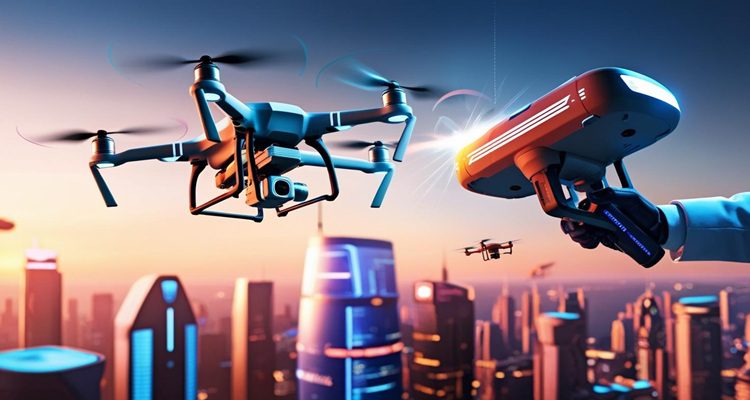One of the greatest security challenges remains detecting low-slow-small (LSS) drones, agile quad-rotors and fixed-wing platforms that operate at low altitudes, move slowly, and present minimal radar cross-sections. Conventional sensors such as 2D radars, optical cameras, and acoustic arrays have proven limited when tasked with identifying these faint, cunning aerial intruders.
A step-change in capability is required. Enter: 3D pulse-Doppler radar. By simultaneously resolving range, azimuth, elevation, and velocity, this technology brings multi-dimensional precision and reliability to the task.
When paired with countermeasures like a sophisticated drone frequency jammer capable of disrupting control links, the defensive ecosystem matures from detection to neutralization. The system under discussion here blends the ability to detect, identify, and mitigate intruders, including through UAV jammers or drone blocker modules built-in.
In this article, we explore how 3D pulse-Doppler radar works, why it outperforms legacy sensors in complex airspaces, and examine how the latest system architecture (ND-BU002 High-End Anti-Drone System) integrates detection, tracking, and jamming into a single coherent solution.
Understanding 3D Pulse-Doppler Radar
A pulse-Doppler radar emits short pulses of radio energy and listens for returned echoes. By measuring the time delay, it determines range; by measuring the Doppler shift, it determines radial velocity. In a 3D version, the system also resolves elevation (“pitch”) as well as azimuth (“yaw”) so that each target is located in full three-dimensional space.
Technically, pulse-Doppler radar determines range by “binning” the echoes of each transmitted pulse according to their time of arrival, essentially converting delay into distance. At the same time, it measures the coherent phase shift across multiple pulses to calculate target velocity, allowing it to separate moving objects from stationary clutter.
High pulse-repetition frequencies eliminate blind speeds but can introduce range ambiguity, which engineers mitigate through digital signal processing and filter banks, often using discrete Fourier transforms. Operating in half-duplex mode, these systems alternate between transmit and receive cycles, achieving high dynamic range and superior long-range detection compared to continuous-wave radar designs.
Advantages Over 2D Radar in Challenging Environments
Where a 2D radar might sweep in azimuth only, neglecting elevation, it leaves blind zones, especially low-altitude, cluttered areas where backdrop clutter (trees and buildings) masks low targets.
A 3D pulse-Doppler radar scans both azimuth and pitch, giving full spatial awareness. That capability enables it to detect LSS drones operating near terrain, amidst urban clutter, or along tree lines, areas where conventional radars struggle. Additionally, the Doppler element helps distinguish slow-moving drones from stationary clutter, improving target discrimination and reducing false alarms. Research confirms this improved performance in cluttered lower-altitude airspace.
ND-BU002 High-End Anti-Drone System Overview
This system comprises:
- Detecting Unit: Employing the advanced 3D pulse-Doppler radar, this unit acquires full spatial tracking of aerial intruders.
- Jamming Unit: A full-band digital jammer that can disrupt control/navigation signals once the intruder has been located, effectively.
- Camera Unit: A visible/thermal electro-optical module that locks onto the target once radar cues it, providing recognition capability and further cueing for jamming decision.
- Integration workflow: Radar locates, then camera verifies/tracks, and jammer neutralizes.
The workflow is elegant and effective: The radar detects a target in 3D space, feeds location and trajectory into the electro-optical team for visual verification/tracking, and then the jamming unit executes disruption of the aerial threat. Because the system integrates all three phases, it avoids the data-handover lags or blind spots found in multi-vendor patchwork solutions.
Detection Capabilities
The radar in the ND-BU002 operates in the X-band (9 to 10.2 GHz) and is rated for a detection range of at least 5 km against small quad-rotors like the DJI Phantom-class. This performance is notable because many legacy systems fail at these ranges when the radar cross-section is extremely low (≈0.01 m²).
Simultaneous Tracking of 200+ Targets with Long Range/High Accuracy
The system surveys and tracks more than 200 targets simultaneously, a critical requirement when faced with potential swarm incursions or densely cluttered airspaces.
Detects Drones and Helicopters with Ultra-Low False Alarm Rate
Because the system resolves elevation, velocity, and range, it differentiates between drones, low-flying helicopters, and other aerial objects. The false alarm rate is exceptionally low for small-drone scenarios.
Performance Highlights
The radar’s architecture uses mechanical scanning in azimuth (0 to 360 degrees) combined with phased-array electrical scanning in elevation (pitch), ensuring targets at varying altitudes can be tracked without blind zones.
Integrated Design Suitable for Fixed Use
Though designed for high-end security applications, the system is ruggedised (IP67 rated), designed for 24/7 operation, and suited for permanent/stationary installation in sensitive sites or perimeter roles.
Real-Time Self-Monitoring and CFAR-Based False Alarm Reduction
The inclusion of Constant False Alarm Rate (CFAR) algorithms and sophisticated signal processing enables the system to adapt to changing clutter conditions, such as urban, foliage, or water reflections, in real-time. This reduces operator burden and increases reliability.
Applications
Border defense, critical infrastructure, event security
Whether safeguarding a national border, protecting a power facility, or securing a mass event venue, the combination of 3D detection and integrated jamming makes the system highly relevant. The inclusion of full-band jamming means that once a drone is detected, its control link or navigation link can be disrupted, mitigating threats proactively via UAV jammers or drone blocker technology.
Adaptability in Urban Clutter or Open Fields
The system’s ability to resolve elevation means it handles both dense urban settings, where drones may fly near terrain or between structures, and open-field environments, where drones can approach from any vector. This versatility is crucial in real-world deployments where threats don’t arrive in uniform profiles.
Integrated Defense for a New Drone Era
In an era when drones are increasingly accessible, the need for robust countermeasures is non-negotiable. Legacy 2D radars, optical-only systems, or acoustic arrays no longer suffice when faced with low, slow, small, and agile intruders. 3D pulse-Doppler radar offers the precision and spatial awareness needed to detect, track, and cue mitigation systems effectively.
The ND-BU002 High-End Anti-Drone System sets a new standard in this regard: It features full 3D detection, integrated camera verification, and jamming modules that work in concert to defend sensitive airspace. For organizations serious about mitigating drone threats, whether through drone frequency jammer, UAV jammers, or drone blocker systems, the path forward is clear. The future of drone detection is three-dimensional, proactive, and fully integrated.





























